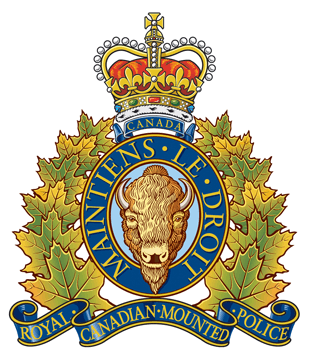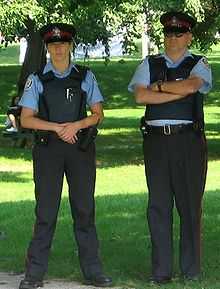Auxiliary constable
Auxiliary Constables or Reserve Constables are unpaid citizens who volunteer their time and skills to a police force. They are uniformed, unarmed members who perform a similar role to their UK counterparts in the Special Constabulary. Their main function is to supplement the police force with additional manpower, with duties varying by appointment, geographical location and the needs of the specific detachment/department.
Durham Regional Police Auxiliary Unit
DRP Auxiliary unit was created in 1977 and provide additional resources to the force. Auxiliary members are involved in community-based initiatives and may be paired with regular officers on patrol. There are 50 members in the unit with 38 as frontline officers.
Halton Regional Police Service Auxiliary Unit
The HRPS Auxiliary unit was founded in 1989, and is composed of 60 trained civilian volunteers. HRPS Auxiliary officers support the regular service as follows:
- Crime Prevention initiatives
- Crowd Control
- Traffic Control
- Car and foot patrol with regular service members
- Bike Unit
- Emergency and Disaster Response
- RIDE initiatives
- Child safety seat clinics
Ontario Provincial Police Auxiliary program
The Ontario Provincial Police Auxiliary program follows a mission statement: “To provide fully trained volunteer Auxiliary Members to perform police duties in special circumstances, including emergencies, when there are not sufficient O.P.P. police officers.”.[1] The O.P.P. auxiliary is a volunteer program where selected citizens receive special training in order to perform many duties such as community policing initiatives and projects, regular patrol, crime and disaster scenes, large gatherings or parades for crowd and traffic control, and traffic control at accidents.[2] The Ontario Provincial Police auxiliary program is the only such Canadian program that requires its auxiliary constables to attend a full-time recruit course conducted near its regular training facility in Orillia,.[2] This is followed by ongoing in-service training at the detachments. The program may also serve as a stepping stone for potential future employment. The O.P.P. Auxiliary has an authorised strength of over 900 auxiliary constables and is the largest police auxiliary unit in Ontario.
It is recognized that the O.P.P. Auxiliary Constables shall not be utilized to replace regular members in any duties. Training must occur for auxiliary personnel to a level to provide necessary skills to safely fulfill the requirements of their mandate under the Police Services Act, and that they participate within those duties which enhance community policing efforts, crime prevention programs, and public service as opposed to direct police service delivery.
The Ontario Police Services Act does, however, provide for instances when the Auxiliary Member may have the authority of a Police Officer. This can occur in an emergency situation where the O.P.P. requires additional strength to cope with a special occasion or event.[1] To insure proficiency, O.P.P. auxiliary constables are required to conduct monthly patrol duties with regular constables.[2] O.P.P. auxiliary constables are not authorised to carry side arms during normal operations, but may be equipped with a long gun when patrolling with a regular member. All O.P.P. auxiliary constables receive annual training with both side arms and long guns. O.P.P Auxiliary members must serve 6 months probation with a coach officer before they can ride with any other officers.
History of the O.P.P. Auxiliary
The O.P.P. Auxiliary was originally formed in 1960 by an Order-in-Council when the program absorbed the Emergency Measures Organization who were trained in crowd control and first aid. The Program was managed by the O.P.P. and its members in the early years helped at community events and patrolled with regular O.P.P. members. Following an audit in 1988 a number of recommendations were made and in 1991 they became self-directed and the Commissioner appointed Auxiliary Chief Superintendent Terry Harkins as its Executive Director; Provincial Commander of the O.P.P. Auxiliary.
The volunteer component developed and included ranks, positions, promotional processes that mirrored the regular O.P.P. structure.
In the new organization the Auxiliary took on the responsibility for standardized selection process and training of its members. The Auxiliary O.P.P. uniform differs only in the light blue shirt they wear as opposed to the dark blue shirt worn by regular O.P.P. members and all components of their outwear bear insignia identifying them as “Auxiliary/Auxiliare”. In 1997 GATB (General Aptitude Test Battery) and Psychological Testing of new auxiliary recruits commenced.
Members of the auxiliary are “unpaid” and receive some compensation for travel and meals. Enrollment requirements are: Canadian citizen or permanent resident of Canada, minimum age of 18 years, Ontario Secondary School Graduation diploma or equivalent, have “standard” First Aid, mentally and physically able to perform duties of auxiliary member, possess a valid drivers license, good driving records and successfully complete the interview process.
Duties
- Traffic control
- Ground security at major events
- Doing surveys
- Seat belt clinics
- Assisting on RIDE initiatives
- Bicycle inspections and rodeos
- Assisting at safety displays and presentations
- Foot and road patrols with regular members
- Accompanying regular members on marine and snow vehicle patrol
- Victim assistance
- Tagging evidence
- Ceremonial duties
- Search and rescue
Ottawa Police Service Auxiliary Unit
Ottawa Police Service's Auxiliary Unit is composed of 13 unarmed volunteers and operational since 2009. Their main duty is community policing. Other duties include:
- Crime Prevention Through Environmental Design (CPTED) audits
- Marine Patrol
- Child Car Seat Clinics
- Ride Alongs
- Assisting in Special Events
- Crime Prevention Initiatives
Peel Regional Police Auxiliary
The Auxiliary program has 100 officers made up of unarmed volunteers. They support regular Peel officers with:
- patrol and marine escorts
- R.I.D.E, program assistance
- special events
- emergency callout
- Auxiliary Honour Guard
- colours at Annual Unit Inspection
Royal Canadian Mounted Police Auxiliary
The RCMP started its Auxiliary programme in 1963 to assist the police during emergencies. The program was created under the Emergency Measures Act, but as time went by, the program evolved into its present day status: complementing the RCMP in general operations.[3] Auxiliary Constables work in Federal/national (RCMP), Provincial and Municipal Police Forces.
RCMP Auxiliary Constables History

- RCMP first introduced the program to the provinces in 1963.
- Restricted to provinces/territories which have policing contracts with the RCMP and have provincial legislation providing for the appointment of auxiliaries.
- Active auxiliary programs are currently in place in all provinces except Ontario and Quebec, which have their own provincial police forces and do not require RCMP. The only exception is the National Capital Region (Ottawa-Gatineau) which is under federal, not provincial, control.
Approximately 2,400 auxiliary members, divided among the different provincial auxiliary programs are currently serving with the RCMP. General policy guidelines are issued from Headquarters. Divisions, in co-operation with the provincial governments, are responsible for organising and administering the program within these guidelines. All costs associated with the program are the responsibility of the provincial government. Uniforms are supplied by the RCMP and costs charged back to the provinces.
Current Status
- Auxiliary members are unpaid volunteers and since they are not employees of the RCMP, they are not entitled to the normal benefits and privileges of regular members.
- Applicants for the RCMP auxiliary constable program are identified in the communities.
- Applicants who volunteer must meet basic requirements.
- Applicants must achieve and maintain a security clearance
- Applicants must volunteer 160 hours annually
- Auxiliary members wear a uniform with shoulder badges showing the word "Auxiliary/Auxiliaire" as well as on their jackets and ballistic vest
- Auxiliaries are authorized to accompany regular members on patrol and perform other police functions under supervision, such as office duties, special events, property checks and traffic and crowd control. Additionally, they often assist regular members during peacetime emergencies and searches for lost persons.
- Participants will be covered by insurance against injury and civil liability and will have completed the approved RCMP training program for auxiliary constables.[4]
Duties
Duties differs between each detachment, but in general, they perform the following tasks:[5]
- Bike Patrols
- Coastal Watch
- Community Police Station /Office/Detachment activities
- Community Policing/ Crime Prevention Display
- Community/ Special Events
- Fingerprinting Children
- Neighbourhood Watch
- Personal Safety Lectures and demonstrations
- Safety talk and activities, such as safety audits
- Traffic Control
Toronto Police Service Auxiliary

Auxiliary members support the regular service in the delivery of community-based crime prevention initiatives and ground searches for lost or missing persons. Members can also be seen volunteering at community events such as parades and fairs and assisting in car and foot patrols. Established in 1957, there are currently 340 auxiliary officers on the force.
- Emergency and Disaster Response
- Community-Based Policing
- Crime Prevention Initiatives
- Traffic Control
- General Patrol
- Crowd Control
- Missing Persons Searches
- Display at Major Malls and Parades
Victoria Police Department Reserve Officers Program
Reserve officers are volunteers whom assist regular officers and the force with:
- crime prevention program
- traffic and special events duties
- regular patrol with regular officers
York Regional Police Auxiliary
120 Auxiliary members support the regular service in the delivery of community-based crime prevention initiatives and ground searches for lost or missing persons. Members can also be seen volunteering at community events such as parades and fairs and assisting in car and foot patrols.
- Emergency and Disaster Response
- Community-Based Policing
- Crime Prevention Initiatives
- Traffic Control
- General Patrol
- Crowd Control
- Missing Persons Searches
References
- ↑ 1.0 1.1 Ontario Provincial Police
- ↑ 2.0 2.1 2.2 Ontario Provincial Police
- ↑ RCMP Auxiliary members (accessed 22/12/06)
- ↑
- Auxiliary members currently DO NOT carry firearms but are trained in their use, but do carry Expandable Batons, Oleoresin Capsicum Spray (OC Spray) aka "Pepper Spray", and Handcuffs.
- In British Columbia, Auxiliary Constables are not police officers and only when they are engaged in duties authorized and accompanied by a regular member in uniform have Peace Officer status but do not have the power to arrest by Ministry policy.
- ↑ Royal Canadian Mounted Police (accessed 22/12/06)
External links
- West Shore RCMP Auxiliary programme
- Peel Regional Police Auxiliary
- Ontario Provincial Police Auxiliary program
- Halton Regional Police Auxiliary Unit
- Canadian Auxiliary/Reserve Constables Forum